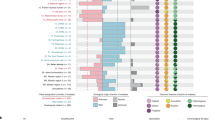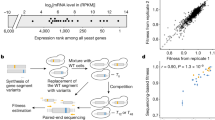Abstract
The self-templating conformations of yeast prion proteins act as epigenetic elements of inheritance. Yeast prions might provide a mechanism for generating heritable phenotypic diversity that promotes survival in fluctuating environments and the evolution of new traits. However, this hypothesis is highly controversial. Prions that create new traits have not been found in wild strains, leading to the perception that they are rare ‘diseases’ of laboratory cultivation. Here we biochemically test approximately 700 wild strains of Saccharomyces for [PSI+] or [MOT3+], and find these prions in many. They conferred diverse phenotypes that were frequently beneficial under selective conditions. Simple meiotic re-assortment of the variation harboured within a strain readily fixed one such trait, making it robust and prion-independent. Finally, we genetically screened for unknown prion elements. Fully one-third of wild strains harboured them. These, too, created diverse, often beneficial phenotypes. Thus, prions broadly govern heritable traits in nature, in a manner that could profoundly expand adaptive opportunities.
This is a preview of subscription content, access via your institution
Access options
Subscribe to this journal
Receive 51 print issues and online access
$199.00 per year
only $3.90 per issue
Buy this article
- Purchase on Springer Link
- Instant access to full article PDF
Prices may be subject to local taxes which are calculated during checkout





Similar content being viewed by others
References
True, H. L. & Lindquist, S. L. A yeast prion provides a mechanism for genetic variation and phenotypic diversity. Nature 407, 477–483 (2000)
Patino, M. M., Liu, J. J., Glover, J. R. & Lindquist, S. Support for the prion hypothesis for inheritance of a phenotypic trait in yeast. Science 273, 622–626 (1996)
Chernoff, Y. O., Lindquist, S. L., Ono, B., Inge-Vechtomov, S. G. & Liebman, S. W. Role of the chaperone protein Hsp104 in propagation of the yeast prion-like factor [psi+]. Science 268, 880–884 (1995)
Kryndushkin, D. S., Alexandrov, I. M., Ter-Avanesyan, M. D. & Kushnirov, V. V. Yeast [PSI+] prion aggregates are formed by small Sup35 polymers fragmented by Hsp104. J. Biol. Chem. 278, 49636–49643 (2003)
Chernoff, Y. O., Newnam, G. P., Kumar, J., Allen, K. & Zink, A. D. Evidence for a protein mutator in yeast: role of the Hsp70-related chaperone Ssb in formation, stability, and toxicity of the [PSI] prion. Mol. Cell. Biol. 19, 8103–8112 (1999)
Lancaster, A. K., Bardill, J. P., True, H. L. & Masel, J. The spontaneous appearance rate of the yeast prion [PSI+] and its implications for the evolution of the evolvability properties of the [PSI+] system. Genetics 184, 393–400 (2010)
True, H. L., Berlin, I. & Lindquist, S. L. Epigenetic regulation of translation reveals hidden genetic variation to produce complex traits. Nature 431, 184–187 (2004)
Griswold, C. K. & Masel, J. Complex adaptations can drive the evolution of the capacitor [PSI+], even with realistic rates of yeast sex. PLoS Genet. 5, e1000517 (2009)
Lancaster, A. K. & Masel, J. The evolution of reversible switches in the presence of irreversible mimics. Evolution 63, 2350–2362 (2009)
Tyedmers, J., Madariaga, M. L. & Lindquist, S. Prion switching in response to environmental stress. PLoS Biol. 6, e294 (2008)
Halfmann, R., Alberti, S. & Lindquist, S. Prions, protein homeostasis, and phenotypic diversity. Trends Cell Biol. 20, 125–133 (2010)
Morimoto, R. I. Proteotoxic stress and inducible chaperone networks in neurodegenerative disease and aging. Genes Dev. 22, 1427–1438 (2008)
Masel, J. & Bergman, A. The evolution of the evolvability properties of the yeast prion [PSI+]. Evolution 57, 1498–1512 (2003)
Alberti, S., Halfmann, R., King, O., Kapila, A. & Lindquist, S. A systematic survey identifies prions and illuminates sequence features of prionogenic proteins. Cell 137, 146–158 (2009)
Crow, E. T. & Li, L. Newly identified prions in budding yeast, and their possible functions. 22, 452–459 Semin. Cell Dev. Biol. (2011)
Halfmann, R. & Lindquist, S. Epigenetics in the extreme: prions and the inheritance of environmentally acquired traits. Science 330, 629–632 (2010)
McGlinchey, R. P., Kryndushkin, D. & Wickner, R. B. Suicidal [PSI+] is a lethal yeast prion. Proc. Natl Acad. Sci. USA 108, 5337–5341 (2011)
Nakayashiki, T., Kurtzman, C. P., Edskes, H. K. & Wickner, R. B. Yeast prions [URE3] and [PSI+] are diseases. Proc. Natl Acad. Sci. USA 102, 10575–10580 (2005)
Wickner, R. B. et al. Prion diseases of yeast: amyloid structure and biology. 22, 469–475 Semin. Cell Dev. Biol. (2011)
Giudici, P. & Kunkee, R. E. The effect of nitrogen deficiency and sulfur containing amino acids on the reduction of sulfate to hydrogen sulfide by wine yeasts. Am. J. Enol. Vitic. 45, 107–112 (1994)
Derkatch, I. L. et al. Dependence and independence of [PSI+] and [PIN+]: a two-prion system in yeast? EMBO J. 19, 1942–1952 (2000)
Sondheimer, N. & Lindquist, S. Rnq1: an epigenetic modifier of protein function in yeast. Mol. Cell 5, 163–172 (2000)
Resende, C. G., Outeiro, T. F., Sands, L., Lindquist, S. & Tuite, M. F. Prion protein gene polymorphisms in Saccharomyces cerevisiae. Mol. Microbiol. 49, 1005–1017 (2003)
Chernoff, Y. O. et al. Evolutionary conservation of prion-forming abilities of the yeast Sup35 protein. Mol. Microbiol. 35, 865–876 (2000)
Liti, G. et al. Population genomics of domestic and wild yeasts. Nature 458, 337–341 (2009)
Jarosz, D. F. & Lindquist, S. Hsp90 and environmental stress transform the adaptive value of natural genetic variation. Science 330, 1820–1824 (2010)
Chien, P., Weissman, J. S. & DePace, A. H. Emerging principles of conformation-based prion inheritance. Annu. Rev. Biochem. 73, 617–656 (2004)
Wickner, R. B., Edskes, H. K., Shewmaker, F. & Nakayashiki, T. Prions of fungi: inherited structures and biological roles. Nature Rev. Microbiol. 5, 611–618 (2007)
Sharma, S. V. et al. A chromatin-mediated reversible drug-tolerant state in cancer cell subpopulations. Cell 141, 69–80 (2010)
Feinberg, A. P. & Irizarry, R. A. Evolution in health and medicine Sackler colloquium: Stochastic epigenetic variation as a driving force of development, evolutionary adaptation, and disease. Proc. Natl Acad. Sci. USA 107 (suppl. 1). 1757–1764 (2010)
Song, Y. et al. Role for Hsp70 chaperone in Saccharomyces cerevisiae prion seed replication. Eukaryot. Cell 4, 289–297 (2005)
Newnam, G. P., Wegrzyn, R. D., Lindquist, S. L. & Chernoff, Y. O. Antagonistic interactions between yeast chaperones Hsp104 and Hsp70 in prion curing. Mol. Cell. Biol. 19, 1325–1333 (1999)
Chernoff, Y. O. Stress and prions: lessons from the yeast model. FEBS Lett. 581, 3695–3701 (2007)
Chernova, T. A. et al. Prion induction by the short-lived, stress-induced protein Lsb2 is regulated by ubiquitination and association with the actin cytoskeleton. Mol. Cell 43, 242–252 (2011)
Masel, J. Cryptic genetic variation is enriched for potential adaptations. Genetics 172, 1985–1991 (2006)
Koonin, E. V. & Wolf, Y. I. Is evolution Darwinian or/and Lamarckian? Biol. Direct 4, 42 (2009)
Halfmann, R. & Lindquist, S. Screening for amyloid aggregation by semi-denaturing detergent-agarose gel electrophoresis. J. Visualized Exp. 17, e838 (2008)
Schacherer, J., Shapiro, J. A., Ruderfer, D. M. & Kruglyak, L. Comprehensive polymorphism survey elucidates population structure of Saccharomyces cerevisiae. Nature 458, 342–345 (2009)
Li, H. & Durbin, R. Fast and accurate short read alignment with Burrows–Wheeler transform. Bioinformatics 25, 1754–1760 (2009)
Li, H. et al. The Sequence Alignment/Map format and SAMtools. Bioinformatics 25, 2078–2079 (2009)
DePristo, M. A. et al. A framework for variation discovery and genotyping using next-generation DNA sequencing data. Nature Genet. 43, 491–498 (2011)
Paradis, E., Claude, J. & Strimmer, K. APE: Analyses of Phylogenetics and Evolution in R language. Bioinformatics 20, 289–290 (2004)
Alberti, S., Gitler, A. D. & Lindquist, S. A suite of Gateway cloning vectors for high-throughput genetic analysis in Saccharomyces cerevisiae. Yeast 24, 913–919 (2007)
Gietz, D., St Jean, A., Woods, R. A. & Schiestl, R. H. Improved method for high efficiency transformation of intact yeast cells. Nucleic Acids Res. 20, 1425 (1992)
Goldstein, A. L. & McCusker, J. H. Three new dominant drug resistance cassettes for gene disruption in Saccharomyces cerevisiae. Yeast 15, 1541–1553 (1999)
Haase, S. B. & Reed, S. I. Improved flow cytometric analysis of the budding yeast cell cycle. Cell Cycle 1, 117–121 (2002)
Diezmann, S. & Dietrich, F. S. Saccharomyces cerevisiae: population divergence and resistance to oxidative stress in clinical, domesticated and wild isolates. PLoS ONE 4, e5317 (2009)
Acknowledgements
We are grateful to L. Bisson and L. Joseph, who provided the Department of Viticulture and Enology yeast collection from the University of California, Davis, USA. We also received strains from G. Fink, E. Louis, F. Dietrich and S. Dietzmann, and L. Kruglyak. We thank M. Taipale, K. Allendoerfer, K. Matlack, L. Pepper, V. Khurana, G. Fink, L. Joseph, A. Hochwagen and G. Walker for materials, discussions, and/or critical reading of the manuscript. N. Azubuine and T. Nanchung provided a constant supply of plates and media. S.L. is a Howard Hughes Medical Institute (HHMI) investigator. This work was supported by grants from the G. Harold and Leila Y. Mathers Foundation and HHMI. D.F.J. was supported as an HHMI fellow of the Damon Runyon Cancer Research Foundation (DRG-1964-08) and by an NIH Pathway to independence award (K99 GM098600). S.K.J. was supported as a summer research student by the Howard Hughes Medical Institute (HHMI) Exceptional Research Opportunities Program (EXROP).
Author information
Authors and Affiliations
Contributions
R.H., D.F.J., A.K.L. and S.L. designed the experiments. R.H. performed SDD–AGE analyses. R.H., D.F.J., S.K.J. and A.C. carried out phenotyping experiments. D.F.J. analysed high-throughput phenotyping data. D.F.J. and A.K.L. analysed whole-genome sequence data. D.F.J. and A.C. performed cytoductions. R.H., D.F.J. and S.L. wrote the paper.
Corresponding author
Ethics declarations
Competing interests
The authors declare no competing financial interests.
Supplementary information
Supplementary Information
This file contains a Supplementary Discussion, Supplementary References and Supplementary Figures 1-4 with legends. (PDF 1979 kb)
Supplementary Tables
This file contains Supplementary Tables 1-3. (PDF 1591 kb)
Rights and permissions
About this article
Cite this article
Halfmann, R., Jarosz, D., Jones, S. et al. Prions are a common mechanism for phenotypic inheritance in wild yeasts. Nature 482, 363–368 (2012). https://doi.org/10.1038/nature10875
Received:
Accepted:
Published:
Issue Date:
DOI: https://doi.org/10.1038/nature10875
This article is cited by
-
Amyloids and prions in the light of evolution
Current Genetics (2023)
-
MIL-CELL: a tool for multi-scale simulation of yeast replication and prion transmission
European Biophysics Journal (2023)
-
Mating can initiate stable RNA silencing that overcomes epigenetic recovery
Nature Communications (2021)
-
The Boggarts of biology: how non-genetic changes influence the genotype
Current Genetics (2021)
-
Mitochondrial-nuclear coadaptation revealed through mtDNA replacements in Saccharomyces cerevisiae
BMC Evolutionary Biology (2020)
Comments
By submitting a comment you agree to abide by our Terms and Community Guidelines. If you find something abusive or that does not comply with our terms or guidelines please flag it as inappropriate.



